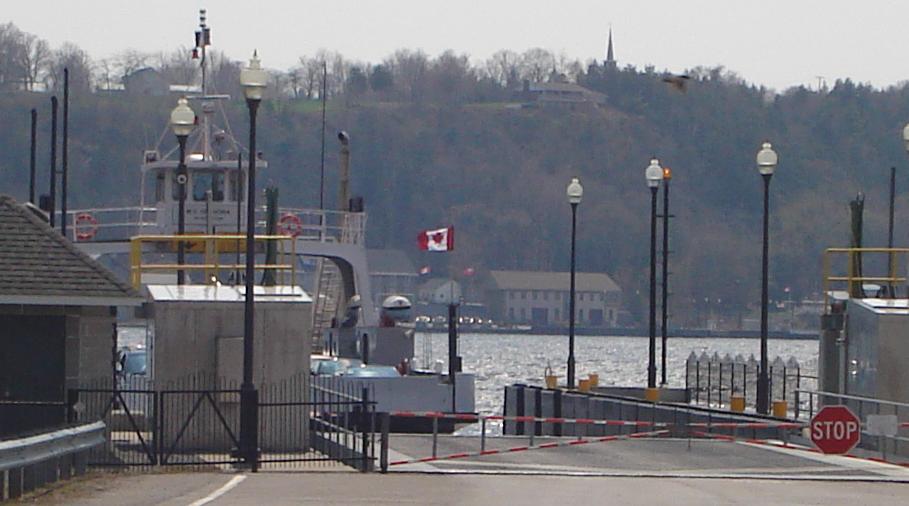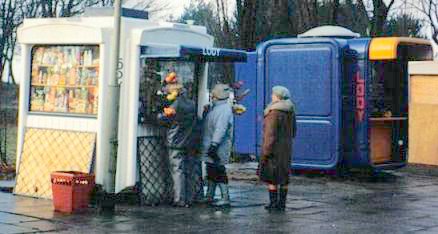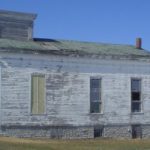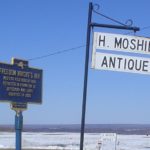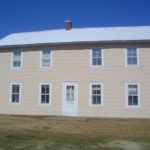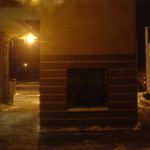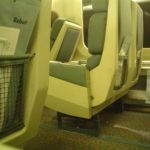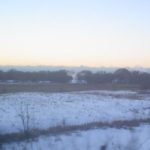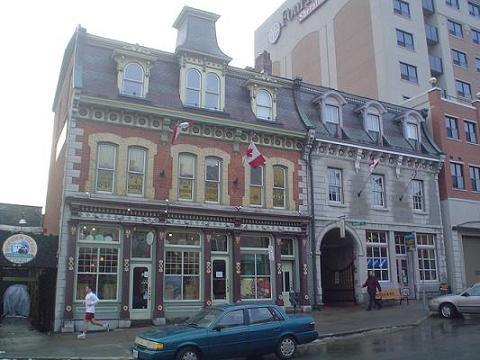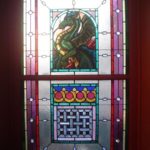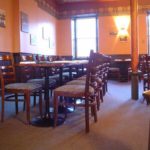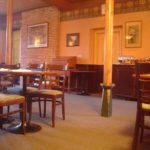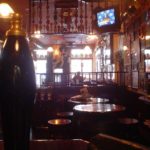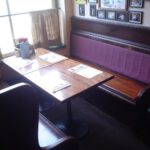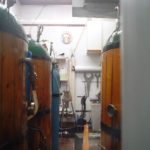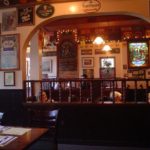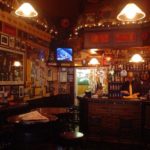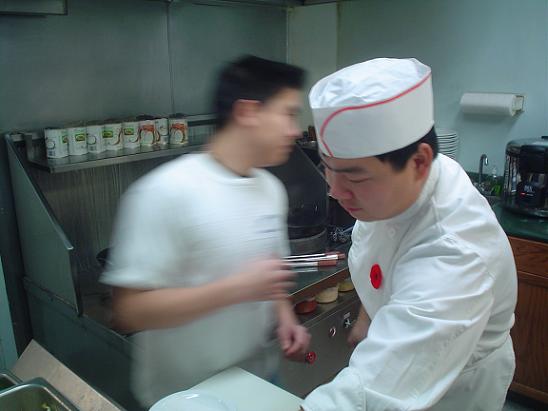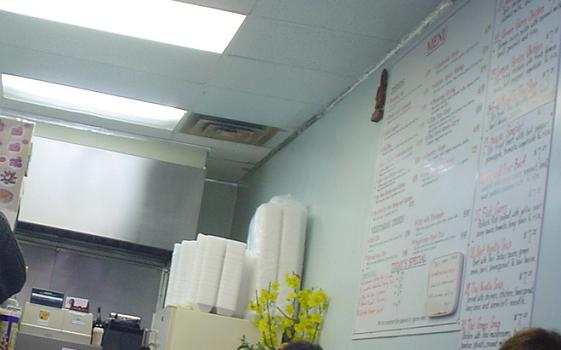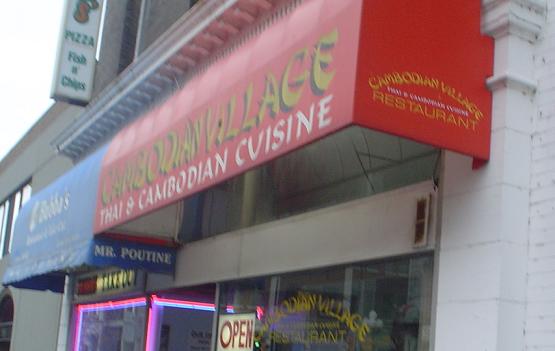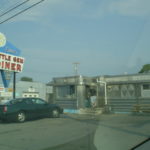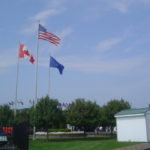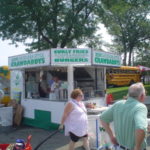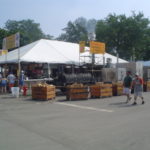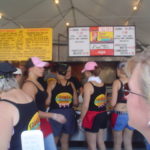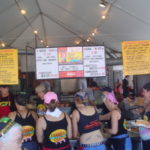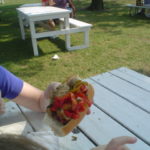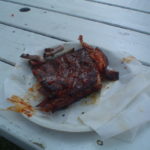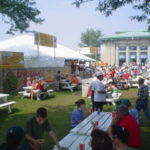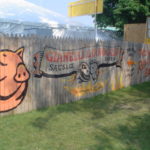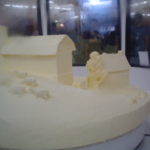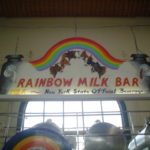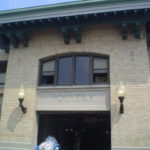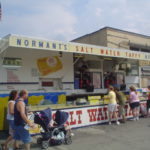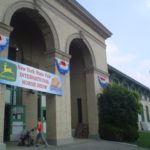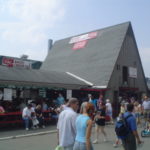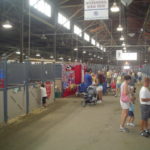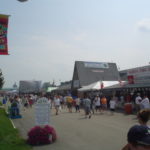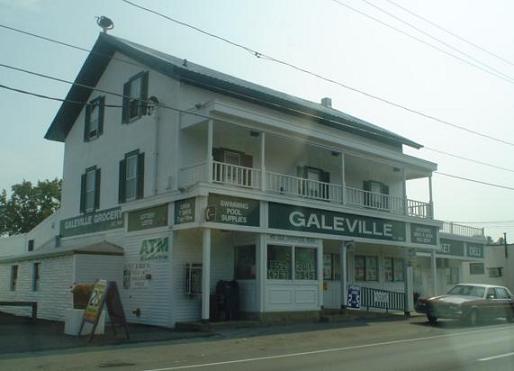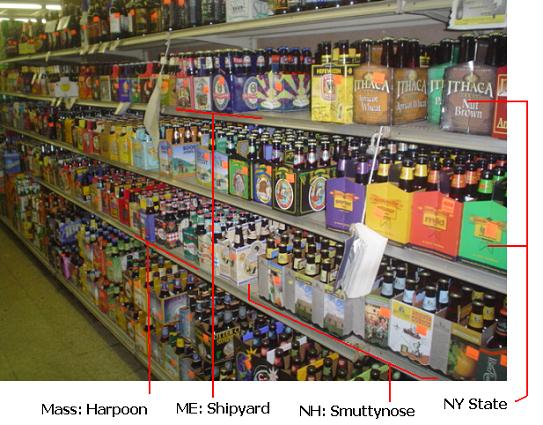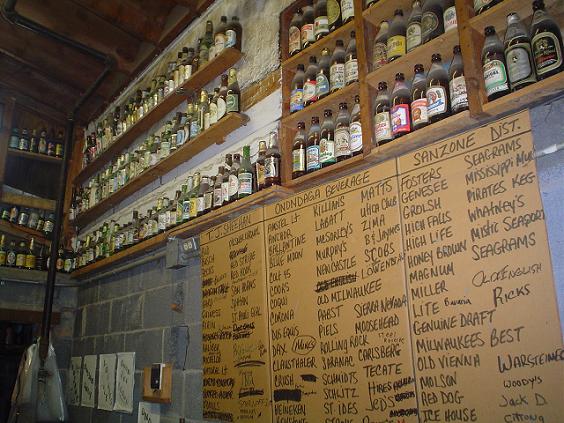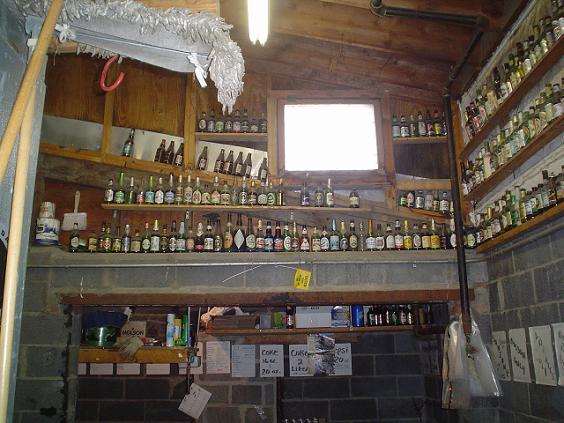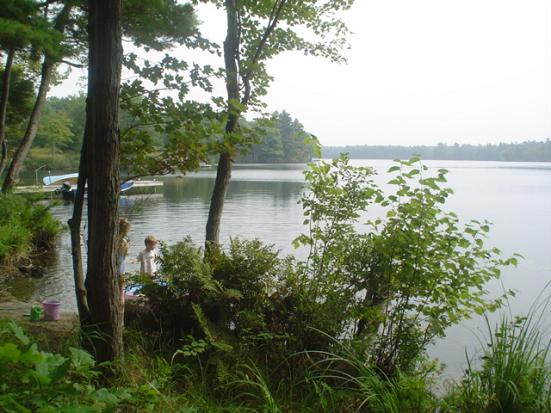Click for a wider shot of the Adolphustown to Glenora Ferry. Battery died in the camera so no shots of the Black River Cheese Company. Maple cheddar is a good thing.
Category: Me and Mine
Zapshack, 1991
With the events in Rome, I find my self rummaging – amazed when I think of it that I was in eastern Europe so soon after the fall of Communism. I have nothing on Bruce “Hubely”, of course, who was on his second stint in Bratislava, later under the Brandenburg Gates on unification, when I flew into Warsaw to spread democracy, the cult of Walkman as well as jokes about President Jarulzelski looking a lot like Roy Orbison to Baltic resort town teens.
We lived well on chelb, pivo and ser but I dreamed of zapjakanky. We bought them in these zapshacks, above. Lody is ice cream, by the way, which is a hell of a lot easier to say than what Brucey had to order in Bratislave, zrma zlina.
Update: Watching the CBC Life and Times episode on the Pope last night, I was surprised how the Vatican was pouring money into Poland as part of the pressure it brought to undermine the wall and it got me wondering if all we twenty somethings brought into eastern Europe by tiny institutions in an oddly organized fashion was backed by Rome to some degree as well. Karol’s little army of westerners pushed out into little cities and towns who had little experience of westerners other than as tank drivers. My students thought we all used one brand, “Wash n’ Go” shampoo, as it was the first to make the market there. That and “The Final Countdown” by Europe was the height of current pop music as someone had a cassette. To counteract that I passed around the Walkman with Blue Rodeo and “My Definition of a Boombastic (Jazz Style)” by Dream Warriors.
Denmark, New York
There are places you hit the brakes. It can be a view but more often than not it is the question of what the heck was going on here. As you can see from these pictures, there are three great stone houses in a row on a rather quite back country road in Lewis County New York. The afternoon shadow across their fronts confirm their eastern orientation facing across the valley. But why, away from a river where mills could develop, did this small hamlet have such a grand life almost 200 years ago. The sign next to the pink sided Freedom Wright’s Inn gives some indication of the importance of the place at one time, as does the solid but closed up church.
The first occupation by Europeans of the area comes relatively late or so sayeth the 1927 The History of New York State (pub., Lewis Historical Publishing Company, Inc.):
The settlement of the northern section of New York was greatly delayed by the ignorance concerning it. Old maps of the section named it Irocoicia. “The Land of the Iroquois,” or Coughsagraga, “The Dismal Wilderness.” Travelers who skirted the edges said it was a region of swamps and mountain barrens. Sauthier’s map, published in England in 1777 and supposed to be the beat and latest in its information, mentions it as “This marshy tract is full of beavers and otters.” There is no map earlier than 1795 that shows a trace of the Black River. Soldiers, possibly those of Sullivan’s expedition, knew something of the territory. But it is in no way surprising that when offers were made to the land commissioners of New York for these supposed waste barrens, that they should be accepted readily, and the land sold for mere pittances and on the easiest of terms. One of the many sales, and the, was that to Macomb. On June 22, 1791, Alexander Macomb made an offer for certain lands, the payment to be one-sixth part of the purchase price yearly until the account was complete, no interest to be charged. The price offered was eight pence an acre. Macomb secured net 3,670,715 acres, divided into six great tracts. The one numbered four included the larger part of the counties of Jefferson and Lewis. Macomb conveyed this tract, with others, to William constable, and he in turn part to others sop that the deeds to Lewis County are traced back to nine great tracts known as: Black River, Inmans’ Triangle, Constable’s Four Towns, Brantingham, Brown’s, Watson’s, Castorland, and Great Tract Number Four.
Early settlers included Bedells and many others. Denmark was the first township to be constituted in 1807 after the founding of the county two years before. Someone of local legal note – who attened Denmark Academy and who studied law… in Lowville – was born there in 1825 as was an Iowa banker in 1833 as well as a Mayor of Ottawa. It wasn’t until about 40 years after its founding that the now larger towns formed in the valley below:
In 1848, the towns of Croghan and New Bremen were formed by French, German, and Swiss immigrants.
These towns were likely created as part of the development of the Black River canal, an unprofitable spur off the Erie, which opened in 1855. Denmark was on one branch of the underground railroad, moving slaves from the US south to Canada. A golf club formed in 1925.
Train
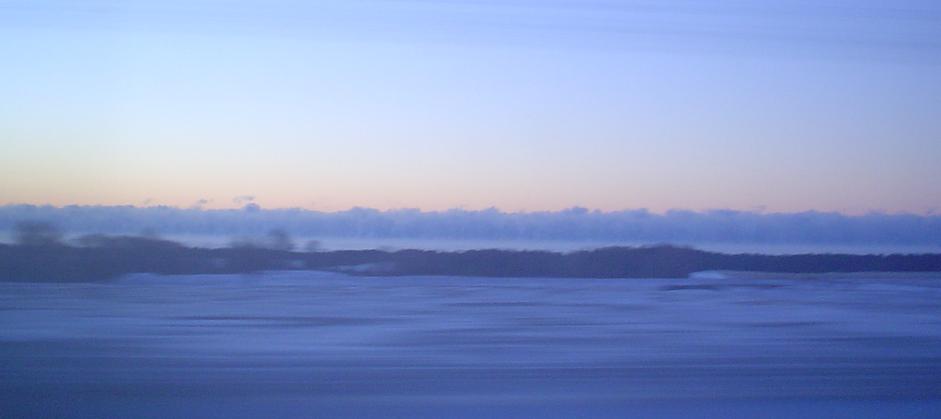
Lake Ontario from the 5:35 am to the Big Smoke. Click if you must.
I met a man on the way back who took the train to and from Detroit every week. Ten hours each way to his work. I was tired of being on the train after two and a half hours. I do not seem to travel well anymore. Maybe it’s because trains in the past took me on holidays rather than work. Not complaining but sitting on a siding in Napanee waiting for the on-coming train to pass is not like heading to Belgium with a backpack when you are twenty three.
These shots are from the way there when I was more wowsie. I was very surprised to see that Lake Ontario was entirely ice-less at the shore near Oshawa. The clouds at the blue horizon in the photo above are the lake effect, laying more snow on Buffalo. VIA Rail could pick a more exciting interior colour scheme than beige and seafoam. They used to be more into navy blue and orange, didn’t they?
Kingston Brewing Company, Kingston, Ontario
Readers in the local area may have noticed I have yet to write about the Kingston Brewing Company, more commonly called the Kingston Brew Pub. It’s just that I have not got a set of photos that capture the place more than anything but I popped in mid-afternoon today and made a start.
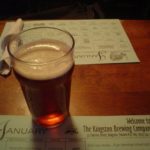 I have been going to the Kingston Brew Pub for more than a decade. When we lived three hours drive away, during LBK (Life Before Kids) we planned long weekends around meals there. Now I work a block away and am happy because of it, even to pop in for the lunch special or a cup of coffee mid-afternoon. The beers on tap are mainly their own but they do have McAuslan Oatmeal Stout and Guinness – based on the belief, I think, that now one can improve much on these examples of the styles. There is a bloggers meet up tomorrow evening there at 5 pm so I will have more thoughts and notes on a couple of ales after that.
I have been going to the Kingston Brew Pub for more than a decade. When we lived three hours drive away, during LBK (Life Before Kids) we planned long weekends around meals there. Now I work a block away and am happy because of it, even to pop in for the lunch special or a cup of coffee mid-afternoon. The beers on tap are mainly their own but they do have McAuslan Oatmeal Stout and Guinness – based on the belief, I think, that now one can improve much on these examples of the styles. There is a bloggers meet up tomorrow evening there at 5 pm so I will have more thoughts and notes on a couple of ales after that.
Later: Ok. I never took any notes. I blabbed about blogs and failed to note the Winter Whallop or the Dragon’s Breath IPA. But I did get a couple of pictures of the upstairs.
Cambodian Village
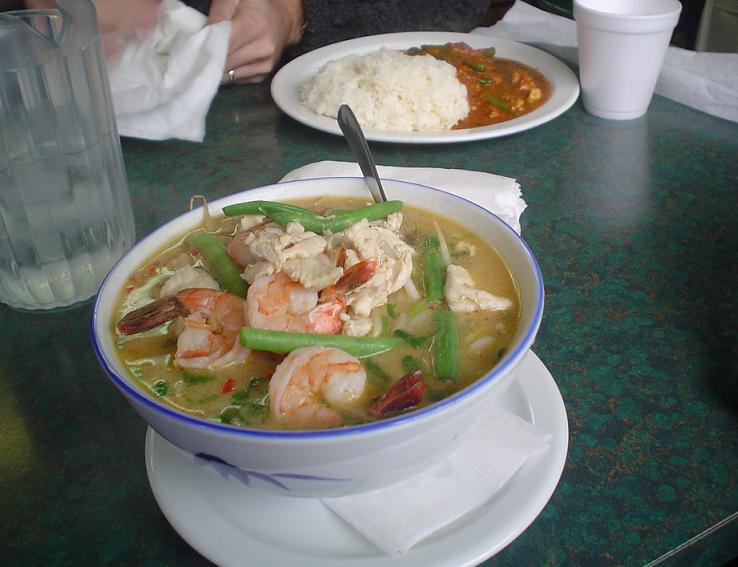
The best thing for a frozen day. Not fancy. Menu on the wall and you drink out of styrofoam. Chef Tran was trained by Mr. Vann I think. Mr. Tran makes a Western Style that is not so explosively hot…though I suspect Chef Vann’s up at Cambodiana is more authentic. Both are the best.
Digger Dance
The last thing we stuck around the New York State Fair yesterday afternoon for was the JCB digger dance. Basically, six heavy construction vehicles are run around a parking lot to music doing a sort of Ed Sullivan era pop ballet. Here are some short short movies:
Here are a whack of photos:
Sunday At The NYS Fair
Here are some pictures from the New York State Fair. The first is actually a diner we passed half lost but near the fairgrounds. You’ll see crawdads, spiedies and dinosaur ribs. Maybe I have not gone to many fairs, but the amazing thing to me about the place was how there were more food booths than carnies. The butter sculpture was amazing…well…interesting enough…I guess. Clean, civilized, packed and stinkin’ hot when the weather was calling for cloudy with rainy spells. Excellent.
Here are two short short movies, the first of a crowd scene [1.5 MB] and the second of the two-seater ride I will never take [2.1 MB].
Beer Shop: Galeville Grocery, Liverpool, NY
Directions to Galeville Grocery
So we hit the road at 8:00 am and were at the fair at 10:30 am after a few stops – one of which was the Galeville Grocery. Unlike Pennsylvania and its restrictive distributor system, New Yorkers have some of the most civilized laws relating to the purchasing of ales. As in Quebec, any corner store can pretty much be one of the best sources you will find. Thanks to a tip from the Homebrewers Digest, we turned off I-81 at the Liverpool turn-off and hunted for the 116 year old shop.
As the photo below shows, it was a small trip into a pretty nice selection of micros. Lots of Ithaca, Brooklyn and other New Yorkers plus a good selection from across the land. They even had sixes of Sleeman’s honey brown for 4.99 which is about 6.50 CND – or 4 bucks less than it costs here in Ontario where it is made. I picked up a variety pack from both Ithaca and Southern Tier as well as a six from each of Brooklyn, Wagner Valley and, because I could, one of Shipyard IPA from Portland Maine. Expect a few comparing and contrasting reviews over the next week weeks including much reference to the works of Lew Bryson.
It was a bit of a lesson in surcharges. The beer cost me $50.45 USD or $67.10 CND. I then paid $2.10 USD New York State bottle return, $3.66 USD New York state tax, $4.00 CND federal duty, $9.64 Ontario Liquor Commission mark-up, $5.44 Canadian Federal Goods and Services Tax, $10.48 Ontario Provincial Sales Tax. Total was $103.78 CND. If I had spent 48 hours in the states it would have only been the $78.20 as there are no border charges but I am not exactly going to plan a three day holiday around saving 29 bucks.

